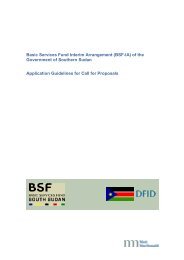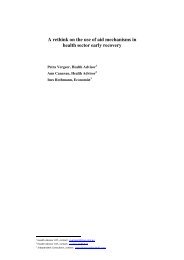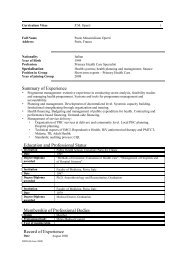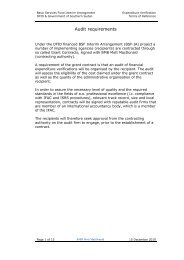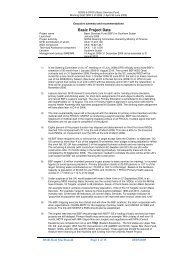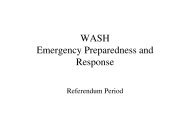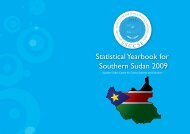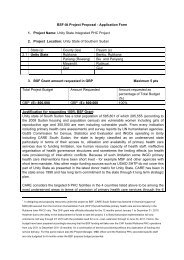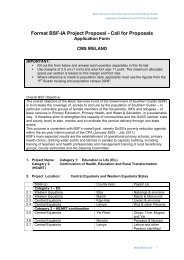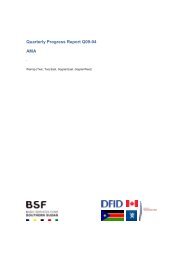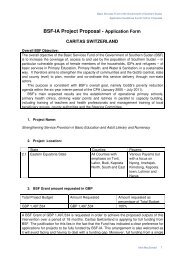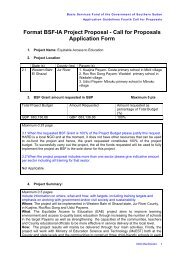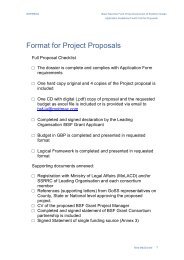Health Institution Latrines - Basic Services Fund SOUTH SUDAN
Health Institution Latrines - Basic Services Fund SOUTH SUDAN
Health Institution Latrines - Basic Services Fund SOUTH SUDAN
- No tags were found...
Create successful ePaper yourself
Turn your PDF publications into a flip-book with our unique Google optimized e-Paper software.
Ministry of Irrigation and Water Resources – Government of National UnityForewordSignificant progress has been achieved in the provision of water and sanitation services inSudan in the last few years. This is attributed to the increased access to many remotevillages as a result of the three major peace agreements, the Comprehensive PeaceAgreement (CPA) between north and south Sudan, the Darfur Peace Agreement (DPA)and the Eastern Sudan Peace Agreement (ESPA), that were signed in 2005 and 2006respectively. This access has allowed the Ministries of Irrigation and Water Resource(MIWR) of the Government of National Unity (GoNU), state governments and sectorpartners (including NGOs and the private sector) to expand water and sanitation servicesin many areas. This prioritizing of the expansion and sustainability of water andsanitation services in urban and rural areas throughout the county, including to thenomadic population has resulted in a steady annual increase in water and sanitationcoverage for the citizens of Sudan.With this expansion in implementation, the MIWR recognized the need to harmonize thevarious methodologies utilized by the various actors in the implementation of water andsanitation interventions. It was agreed that this could be best achieved through thedevelopment and distribution of Technical Guidelines, outlining best practices for thedevelopment of the 14 types of water supply and sanitation facilities in the Sudan. TheseTechnical Guidelines, compiled in a systematic manner will undoubtedly set standardsand provide guidance for all water and sanitation sector implementing partners.The MIWR of the GoNU of the Sudan is grateful to UNICEF, Sudan for financial andtechnical support in the preparation of the Technical Guidelines.I believe these Technical Guidelines will go a long way to improving WES sectorprogrammes, allowing for scaling up implementation of activities towards achieving theMDG goal for water supply and sanitation in Sudan.MinisterMinistry of Irrigation and Water ResourcesGovernment of National Unity, KhartoumDate ………………………………………2
AcknowledgementsSpecial thanks go to Mr Mohammed Hassan Mahmud Amar, Mr Eisa Mohammed andMr Mudawi Ibrahim, for their directions on GONU’s sector policy; Engineer IsaacLiabwel, on GOSS’s water policy; Mr Sampath Kumar and Dr. Maxwell StephenDonkor, for their direction on the WASH sector from the UNICEF perspective, and forthe provision of relevant documents & information, and facilitating & organizing anumber of forums to discuss draft documents.The author would also like to thank WES and UNICEF staff of North Darfur, NorthKordofan, South Kordofan, Sinnar, Gedaref, Kassala, Red Sea and Blue Nile States; thestaff of DRWSS, and UWC in Central Equatoria, Western Bahr el Ghazal, Warap andUpper Nile States; and the staff of UNICEF Zonal Offices responsible for thearrangement of meetings with sector partners and successful field trips to the variousfacilities.Many thanks to Emmanuel Parmenas from MWRI, and Mr Mohammed Habib and MrJemal Al Amin from PWC, for their contribution in collecting documents andinformation at the national and state levels, facilitating field trips and contacting relevantpersons at state level and to the latter two for their support in translating documents andinformation from Arabic into English.The completion of this document would not have been possible without the contributionsand comments of staff of SWC, PWC, MIWR, MCRD, MWRI, MOH in GONU, MAF,MARF, MOH MHLE, MWLCT and SSMO in GOSS, UNICEF, National andInternational NGOs like Oxfam GB, Pact Sudan, SNV, SC-UK, and Medair, and reviewworkshop participants at state and national levels and members of technical workinggroups.5
• Although a minimum distance of 15m is allowed in other countries, in Sudan it isrecommended that pits are located at a minimum distance of 30 to 50 meters awayfrom drinking water sources (tube wells and hand dug wells) depending on soilcondition. The distance depends on hydro-geological conditions such as texture of thesoil and groundwater depth and flow. When groundwater levels are high or when thesoil is too hard to dig, the pit may have to be raised above ground level.• Hand washing facilities must be provided beside each latrine.• A bin for hygienic disposal of sanitary materials must be provided in every chamberin the latrine.9
1. Introduction1.1 The purpose of this documentThe Ministry of Irrigation and Water Resources (MIWR), GONU, and the Ministry ofWater Resources and Irrigation, (MWRI), GOSS, are responsible for the policy andstrategy development, coordination, planning, management, monitoring and evaluation ofwater supply and sanitation facilities in the country. In order to reduce disparities,improve standards, accelerate implementation and to standardise design and costs, thetwo ministries agreed to harmonize the methodologies utilised in the implementation ofWATSAN interventions Currently, there is no standardised document providingTechnical Guidelines for implementation by WES or other water and sanitation agenciesand this is detrimental to the longevity of structures and the sustainability ofinterventions.In 2006 MIWR and MWRI decided to develop Technical Guidelines for the constructionand management of rural water supply and sanitation facilities. These Guidelines are acollection of global and national good practices in water and sanitation that have beencollated. The process of the development of the Technical Guidelines is outlined inAnnex 1.These simple Guidelines are primarily intended as a reference for field staff andpractitioners in the water and sanitation sector challenged by situations and conditions inthe field.Updating of the Guidelines is recommended biennially; to ensure newer and betterpractices are incorporated as they are developed/ introduced. Water and sanitation sectorimplementing partners should contribute in providing feedback to the MIWR and MWRIas necessary during the updating.1.2 Available sanitation technology optionsSanitation systems worldwide can be classified into two major categories, namely: offsiteand on-site sanitation systems. The conventional sewerage system with propertreatment and disposal, and small-bore sewers are classified as off-site sanitation systemswhilst, others such as dry pit latrines, borehole latrines, ventilated improved pit latrines,eco-san latrines, pour-flush latrines (with single or twin pits), aqua privies, compostinglatrines (like eco-sans), and septic tanks fall under on-site sanitation systems.The off-site systems are not suitable in peri-urban and rural areas of developing countrieslike Sudan for the reasons indicated below::• A Conventional sewerage system is highly capital intensive and beyond the financialresources of the communities in developing countries and particularly for scatteredand small populations. It also involves sophisticated treatment systems and skilledoperators for management, operation and maintenance and a large quantity of water is10
Local authorities also play a significant role in the facilitation of the implementation ofthe sanitation facilities. Problems that may arise during the implementation of the watersupply system sanitation facilities such as for example, land ownership, could be easilysolved if the local authorities are brought on board and are involved in the decisionmaking process. Problems can only be identified by the active involvement of allstakeholders.4 Guideline for the selection of the type of latrines to be constructed in a ruralhealth institution.Rural health institutions in Sudan refer to clinics, health centers, and health posts in nonurbanareas. <strong>Latrines</strong> constructed in these institutions should comply with the followingbasic requirements.• <strong>Latrines</strong> should be hygienic, free from bad smells, inaccessible to flies and otherinsects, and should not contaminate ground water.• The presence of a sanitary latrine should promote good hygiene behavior.• <strong>Latrines</strong> should be simple in design and the construction, operation and maintenance ofthe facility should be easy enough for semi-skilled personnel.• <strong>Latrines</strong> should ensure safe disposal of excreta.• <strong>Latrines</strong> should be culturally acceptable to the users and allow regular service withoutinterruption.• <strong>Latrines</strong> should be low-cost and should allow as much as possible the use of locallyavailable materials that do not impact the environment negatively• They should provide the minimum requirement of safety and privacy to the users(patients and health workers).• Every latrine should have the following basic components:•o A platform on which the user can squat to defecate easily and safely. Theplatform may have a squatting pan, a simple drop hole or a straight pipe. Thenumber of drop holes or pans depends on the number of users. On average, onedrop hole is sufficient for some 50 people in a day.o Where it is anticipated that emptying of the pit is possible, a manhole should beprovided on the slab or the squatting slab is easily removable from the pit.o A superstructure to provide privacy. Vent pipes with fly screens should beprovided outside of the superstructure.o A substructure (pit) for storage and disposal of excreta. In unstable soil condition,the pit must be lined with locally available materials like bricks, stones etc.o A hand washing facility to promote good hygienic practices.5 Rural health institution latrines5.1 Types of rural health institution latrines13
The types of latrines that have been considered for comparison include: Pour-flushlatrines (water based latrines), ventilated improved pit latrines, improved traditional pitlatrines, aqua privies (water based latrines) and composting (Ecosan) latrines.Pour-Flush (PF) Latrine with Leaching PitThe PF has a squatting pan with a water seal, in addition to a leaching pit and thesuperstructure, The squatting pan and the water seal can be fixed independently or on topof the pit. When the pan is fixed independently, a connecting pipe is necessary to conveythe excreta with the flushed out water to the leaching pit.This type of on-site sanitation facility is appropriate for rural and peri-urban areas wherethere is sufficient water for flushing and the soil is permeable. This design reduces smellsand the breeding of flies, and is also appropriate when water is used for anal cleansing.About 2 to 5 litres of water is required for flushing depending mainly on the pan designand the distance to the pit; less water is required for a shorter distance.Ventilated Improved Pit (VIP) <strong>Latrines</strong>The VIP have two major components; an underground pit to accumulate the excreta, anda superstructure for squatting and which provides privacy and shelter from rain, sun etc.The pit is covered either by a concrete or plastic slab. The pit may or may not be lined.There are vent pipes attached to the pit that let the foul air out from the pit. The drop holeis always open and the squatting space is always be dark.The user can choose the construction material for the superstructure, which can be localbricks or wood for the walls and thatch or corrugated iron for the roof.These types of latrines are appropriate for rural institutions like schools. They can beconstructed from locally available material and need only semi-skilled labour. A VIP canbe easily replicated. This design reduces smells and the breeding of insects.A VIP latrines differs from a traditional latrine only through the attachment of a vent pipecovered with a fly screen. Wind blowing across the top of the vent pipe creates a flow ofair which sucks out the foul smelling gases from the pit. As a result fresh air is drawn intothe pit through the drop hole and the superstructure is kept free from smells. Flies thatenter the pit through the drop hole are attracted to light and if the latrine is suitably darkinside, the flies will fly up the vent pipe to the light. They cannot escape because of thefly screen, so they are trapped at the top of the vent pipe until they dehydrate and die.The cost for this type of latrine includes: materials (60-80%), transport (5-30%), andlocal labour (10-25%). %). The cost also depends on the volume of the pit, quality oflining (when lining has been applied), slab and superstructure, the use of locally availablematerials, and the region of implementation.Composting (Ecosan) <strong>Latrines</strong>14
.This type of latrine can be constructed with single or double vaults, and consists ofwatertight chamber(s) to collect faeces. Urine is collected separately as the contents ofthe vault need to be kept relatively dry. The urine is diverted to a urine container placedoutside the latrine and can be diluted with 3 to 6 parts of water for use as a fertilizer fora vegetable or fruit garden. Otherwise, it can be diverted away to a soak-away pit. Inareas where water is used for anal cleansing, a separate diversion system should beincorporated so that this water can be diverted to a soak-away pit.The pedestal or squatting plate should therefore have three sections: one that allowsfaeces to go down to the pit, one to convey urine to a urine collection container (pot) andone to carry waste water from anal cleansing to a soak-away pit.A separate location for faeces composting should be allowed for a single vault ecosanlatrine. The organic soil fertiliser will be pathogen free and ready for use in a year.This type of latrine is appropriate in areas where people would consider the use of humanexcreta as a fertilizer.Ecosan latrine replicates nature by returning the plant nutrients in human urine and faecesto the soil. Instead of polluting the environment, human urine and faeces are used toimprove soil structure and supply nutrients 2 .Improved Traditional Pit (ITP) <strong>Latrines</strong>This type of latrine is non-water based and appropriate for rural institutions like ruralclinics and health centres. It is simple enough to be constructed with local materials byunskilled and semi-skilled labour. It doesn’t, however, guarantee reduction of smell andbreeding of flies. On the other hand, water is not used for anal cleansing and flushing.A small amount of water that is required for cleaning of the surface of the squatting slabmay be allowed to get into the pitThe cost for this type of latrine includes: materials (50-80%), transport (0-25%), andlocal labour (15-35%). The cost also depends on the volume of the pit, quality of lining(when lining has been applied), slab and superstructure, the use of locally availablematerials, and the region of implementation.Aqua Privies (AP)Aqua privies are more appropriate for rural and semi-urban areas where water is availableand the service of emptying the pit is not a problem. This system requires a soak awaythat will allow the liquid effluent to soak into the ground. Raw sewage is a health hazard.5.2 Steps in selection of different types of rural health institution latrinesThe appropriateness of the latrines discussed above, for any health institution, dependsmainly on availability of water in the institution and a proper method of disposal of the2 Ecological Sanitation, editors and co-authors; Uno Winbald and Mayling Simpson-Hébert15
content (excreta) of the pit. Stakeholder consultation is essential to decide on the type oflatrine to be constructed. <strong>Health</strong> workers, local authorities, health institutions, andcommunity representatives should be made aware of the cost related to each type and theamount of contribution expected from them. The end-users must also be shown how toensure proper function of the latrine. Roles and responsibilities for operation,maintenance and replacement must be discussed and fully accepted by all stakeholders.Table 1 compares the pros and cons of the various types of latrine suggested above.Table 1: Comparison of different types of latrines against some criteria set under section 2Type Affordability inSuitable for Social customs and habitsof terms of costlatrineWater users Non water usersITPVIPPFEcosanAPIt is thecheapest of allMore expensivethan ITPMore expensivethan AP andecosan, if it istwin pitMore expensivethan ITP andsingle pit VIPMore expensivethan ITP andVIPReducessmell andinsectbreedingWaterrequirementfor flushingNoNot appropriate as itgets filled quicklyAppropriate No NoYesNot appropriate as it Appropriate No Nogets filled quicklyYes Appropriate Not appropriate Yes NoNo Not appropriate Appropriate No YesYes if thelevel of theliquid isproperlymaintainedAppropriate Not appropriate Yes NoThe type of rural health institution latrine constructed must support the hygiene messagesdisseminated. In this regard a water based type of latrine should be prioritized above allother types.If a school can afford the cost and water is available for flushing, a PF type would be thebest option; either a single pit (where recycling of human waste is unacceptable) ordouble pit where recycling of human excreta as a fertilizer is acceptable. Thepermeability of the soil must be right for the leaching pit(s) to function properly.Where a PF latrine is not feasible an ITP latrine would be the next option. This type oflatrine does not however, guarantee reduction of smell and breeding of flies. In mostcases, it is difficult to promote hygiene education, where reduction of smell and breedingof flies are not guaranteed. It might, however, be appropriate where water is not beingused for anal cleansing and where water for flushing is not needed.Other types of latrines like VIP, aqua privies, composting latrines are not consideredsuitable for the following reasons:Possibilityof use ofthenutrients ofexcreta16
• VIP latrines require a dark superstructure for efficient performance, and this is notappropriate for patients like the elderly, children, pregnant mothers, etc. Where stoolexaminations are provided, a water based system would be essential to allow flushing.Water for flushing is restricted in VIP latrines.• Aqua privies, although water based, require a soak away pit and regular emptying ofthe pit. This may be problematic for health institutions as the content of the pit isunhygienic, and needs special handling.• AP latrines require a large and water tight tank to accommodate both human faecesand liquid before the effluent is directed to the soak pit. This makes the constructioncost very expensive.• Composting latrines require commitment of using the human waste as fertilizer afteremptying the vaults. They also restrict the use of water for anal cleansing and thismay not be acceptable by the primary users. There is also no guarantee in restrictingof harmful disposable materials reaching into the vaults. These harmful disposablematerials may not be decomposed in the vaults.6 Design and construction of latrines for health institutions6.1 Design and constructionMinimum standards• For each health institution, ensure one sanitary latrine for 50 users, with a minimumof 3 squatting slabs; one for women, one for men and a separate one for the staff.. Aminimum space of width of 1.50m and length of 1.50m should be provided for everysquatting space.• Pits can be rectangular or circular, base don the soil type: Circular pits in looseformation and rectangular pits in hard and stable formation.• Although a minimum distance of 15m is allowed in other countries, in Sudan it isrecommended that pits are located at a minimum distance of 30 to 50 meters awayfrom drinking water sources (tube wells and hand dug wells) depending on soilcondition. The distance depends on hydro-geological conditions such as texture of thesoil and groundwater depth and flow.• When groundwater levels are high or when the soil is too hard to dig, the pit mayhave to be raised above ground level.• Hand washing facilities must be provided beside each latrine in every rural healthinstitution.• A bin for hygienic disposal of sanitary materials must be provided in every chamberin the latrine.17
6.1.1 Volume of the pitPits can be rectangular or circular. The volume of the pit may be calculated from theequationV = A + BV = 0.3CPN + 0.75 x w x l x h …………for rectangular pitV = 0.3CPN + n x 0.75 x h x П x d 2 /4 ...for series of circular pitsWhere:A is volume of accumulated sludge and is equal to 0.3 CPN in m 3 .B is volume of free space above the sludge and is equal to (0.75 x w x l x h) forrectangular pit or (n x 0.75x hxПxd 2 / 4) for circular pit in m 3C is sludge accumulation rate or effective capacity per capita per year in m 3 /c/y. Thisfigure varies from 0.04 to 0.09 3 and 0.045 to 0.050 4 . For Sudan situation it was arbitrarilytaken as 0.06m 3 /c/y even though there are no available researched data for this.P is the number of visitors using the latrine.N is the number of years the pit is to be used before emptying.h is the most top depth of the pit which is 1 m in this casew is the width of the pit in ml is the length of the pit in md is the diameter of a single pit in mThe factor 0.3 has been introduced taking into considerations that such latrines are notgoing to be used during certain hours of the day, and a factor 0.75 has been introduced asthe pit is to be emptied or filled with earth when the level of the waste in the pit has a freespace of one quarter of a meter from the squatting level.6.1.1.1 Pour-Flush Latrine with Leaching Pit (Figures 1 to 3)This type of latrine is recommended only where there is adequate water in the school forflushing and the soil conditions allow adequate infiltration of the liquid into thesurrounding media. A Pour-flush latrine with a leaching pit is installed with a pan with awater seal (a U-shaped conduit partly filled with water) in the defecation hole. Thisovercomes the problems of flies, mosquitoes and odour. After use, the latrine is flushedby pouring water into the pan. The concrete floor slab with the pan is either on top of theleaching pit (direct system) or a short distance away (offset system). Pits are usually linedfor strength, but adequately permeable for infiltration.3 Engineering in Emergencies, second edition 2002, Jan Davis and Robert Lambert4 Indian research institutes and UNDP TAG- Global projects18
.In offset systems a short length of sufficiently sloping PVC tube leads from the U-trapdown to the pitThe size of the leaching pit depends on a number of factors such as: soil properties,number of users, water table conditions and the quantity of water being used for flushingand anal cleansing. The volume of the pit can be calculated using the equation givenabove, but it is recommended from experience that the volume is increased under wetcondition by 50% over that in dry conditions. In this regard the required volume will be8.1m 3 ((0.3 x 0.06 x 100 x 3 + 2 x 0.75 x 1.0 x П x (1.5) 2 /4))6.1.1.2 Improved traditional pit latrines (Figures 4 to 7)A traditional pit latrine usually consists of a single rectangular or circular pit covered by areinforced concrete slab. Each latrine will have 3 drop holes which would suffice a healthinstitute serving about 100 visitors in a day.The volume of a pit can be calculated using the equation given above. For example for ahealth institution to serve about 100 visitors a day and sludge accumulation of 0.06m3/p/y in a pit in three years period , the accumulated sludge volume will be 5.4m3which requires a rectangular pit size of width of 1.2 m, length of 2.4 m and depth of 2 m.A circular pit that has a diameter of 2m will have equal volume. In order to allow the pitto serve for more than three years, the depth of the pits could be increased from 5 to 7meters. Therefore, the minimum dimensions of the pits should be as indicated below.Rectangular pit 5 : 1.2m of width, 2.4m of length and 5-7m of depth,Circular pit: 2m of diameter and 5-7m of depth.6.1.2 Depth of a pit6.1.2.1 PF LatrineA latrine with two circular leaching pits of diameter 1.5m each and 4.5m depth would beenough to serve about 100 visitors a day, These dimensions, can be adjusted based on theavailability of space. An additional depth of 0.5m for freeboard would be sufficient toprovide for leaching pits.6.1.2.2 ITP LatrineThe depth of an ITP pit may vary from 5 to 7 meters depending upon the stability of thesoil. As a general rule, in areas where surface water is expected to flood, the lining of thelatrine and squatting slab must be raised above the expected line of flooding (at least by0.15m). Where digging is difficult due to hard formation, the pit can be constructedabove the hard formation, and the lining and squatting platform raised above ground levelin order to acquire the desired pit volume. The lining must, in this case, be water tight toavoid seepage out of the latrine and to prevent surface water getting into the latrine.5 These dimensions should not be considered as absolute. They will depend on the availability of space, andmay be changed by the designer.19
6.1.3 Lining of a pit6.1.3.1 PF LatrineThe pit can be lined with bricks or stones and should allow infiltration of the liquid partinto the soil.6.1.3.2 ITP LatrineThe pit must be lined if the soil condition is loose or unstable, with locally availed redbricks or stones. Where the pit is rectangular, additional reinforcement is required withintermediate beams around the lining at one third and two thirds of the depth of the pit (inaddition to the top and bottom tie beams). There is not need to line this pit in stable soil;however, care should be taken to ensure that rainwater does not enter the pit. This is doneby raising the floor by at least 0.15m. A proper foundation for the reinforced concreteslab with a minimum depth of 0.5m should also be constructed.6.1.4 Squatting platform (reference below is to the cover slab??)6.1.4.1 PF LatrineThe cover slab of the leaching pit is circular slab and is usually from reinforced concrete.The slab has a thickness of 75mm. The squatting platform can be constructed separatelyfrom that of the leaching pit. The squatting slab is usually a concrete floor with a pan(made from concrete, ceramic or fiber reinforced plastic) with a U-water seal attached(refer Figure 3.2). A PVC pipe of minimum diameter of 100mm further connects the U-seal with the leaching pit. Manholes are included at appropriate positions. The shorter theconnecting pipe, the less water required for flushing. The concrete mix ratio of cement:20
sand: aggregate should be 1:2:4, complying to British Standard 5328. According to thisstandard, 1m 3 of reinforced concrete (in mild conditions), requires 6 bags of cement (each50kg), 490 liters of sand and 800 liters of aggregate. are required.6.1.4.2 ITP LatrineThe squatting platform could be constructed from one monolithic reinforced concreteslab cast in-situ or two removable slabs supported by an additional central beam. The slabhas a thickness of 10cm. The concrete mix ratio of cement : sand : aggregate by volumeshould be 1:2:4, complying to British Standard 5328. According to this standard, 1m 3 ofconcrete will require 6 bags of cement (each 50kg), 490 liters of sand and 800 liters ofaggregate under mild conditions.The squat holes can be covered with a lid made of a suitable locally available materiale.g a wooden plank. This will prevent the entry of flies and other insects into the pit andreduce odours. A handle should be attached to the lid to facilitate lifting for users.During emergencies, however, plastic or concrete slabs of size of 600x800mm or1000x1200mm can be used in the early stages of the emergency. However, supportingbeams (100mm in diameter and 1400mm in length) must be provided, two beams perslab. These beams can be made from locally available wooden planks (preferably termiteresistant).21
CLeach pit:Internal diameter ofleaching pit (D) 1500External diameter 2000for brick lining & 2100for stone liningSquatting slab couldbe either from:-Cement concrete,-Ceramic or-Fiber reinforcedplasticManeholeD 1CPVC or cementmortar pipe, dia 100D 2ManholeInternal 600 x 600,external 840 x 840 forbrick lining & 1200 x1200 for stone liningFigure 1: Schematic Plan of Pour Flush Latrinefor rural health institutionsAll dimensions are in mm unless otherwise specified22
Section C – CDrawing not to scaleT 215002500 200Min freespace75T 1600T 1150DiversionBox1500250200Min4500500200H1250Honeycomb liningMinimum thicknessT 1 T 2Brick wall 120 250Masonry wall 300 300Detail of squatting slabNote:-The walls of diversion box, manholesand leaching pit should be raised bymin 150 from the ground level toprotect them from any possibleflooding.-The depth of a diversion box (H 1 )depends on the slope of the connectingpipe. However the minimum internaldepth should not be less than 200.U - sealSquatting slab (either from cement mortar, ceramics or fiber reinforcedplastic) fixed on plain concretePlain concrete, thickness 100Hard core minimum 300Figure 2: Sectional Drawing of Pour Flush Latrinefor rural health institutionsAll dimensions are in mm unless otherwise specified23
25 790 (1150) 25790 (1150)25 25840 (1200)60 60790Reinforcement schedule for aManhole-For brick wall:2x9 steel bars of diameter10mm, c/c 100, and length of 910 each-For masonry wall: 2x12 steel bars ofdiameter 10mm, c/c 95, and length of 1210each70Diameter of all reinforcement bars10mm.and their lengths are 910 or 1210 eachAll dimensions are in mm and drawingis not to scaleFigure 3: Reinforcement bar schedule for rectangular manholecovers of Pour Flush latrine for rural health institutions24
20002500 (2600)t 1200tt2400tLining material Min tRed brick 25Stone 30Note:• The thickness t depends on the depth of the pit andthe type of lining material. For rectangular pit tshould be calculated based on all pressures the exerton the lining material• Rectangular dimensions of pit. Internal 1200 x 2400• Circular, internal diameter 2000• Minimum depth of pits 2000Figure 4: Dimensions of rectangular and circular improvedtraditional pit latrines for rural health institutions25
Manhole size of600 x 600250Squatting paneither from:-Cement concrete,-Ceramics, or-Fiber reinforcedplastic1500B1500250 120B1500 1500250 120Hand washing facility1000PVC Vent pipe dia. 1002000tDiameter = 20005000 - 7000tSection B - BFigure 6: Improved traditional pit latrine with circular pitAll dimensions are in mm and drawing not to scale27
Note: Minimumcoverage ofreinforcement bar is 25G 2PABCD25EGFH 1CF 2HF 1IG 1BType ofbarH 2AShapeJI 1I 2K2450Length ofeach bar(mm)LQuantityMN25O-Reinforcement barschedule for onecover slab of leachingpits.-Drawing not to scale.-All dimensions are inmm unless otherwisespecified75Total length(mm)A ____ 690 4 2760B ____ 1245 4 4980C ____ 1580 4 6320D ____ 1830 4 7320E ____ 2030 4 8120F ____ 2170 2 4340F 1 ____ 1285 2 2570F 2 ____ 285 2 570G ____ 2280 2 4560G 1 ____ 1340 2 2680G 2 ____ 340 2 680H ____ 2360 2 4720H 1 ____ 1380 2 2760H 2 ____ 380 2 760I ____ 2415 2 9660I 1 ____ 1405 2 2810I 2 ____ 405 2 810J ____ 2450 4 9800K ____ 2450 2 4900L C 7910 1 7910M C 5860 1 5860N C 4010 1 4010O C 2055 1 2055P ____ 860 8 6880Figure. 7: Reinforcement bar schedule for cover slabs of circular pit of improved traditional pit latrine for ruralhealth institutions.28
6.1.5 Superstructure6.1.5.1 PFLLocally available materials like mud bricks, red bricks, etc. can be used for theconstruction of the walls of the superstructure. The roof can be also be constructed fromdurable local materials. The type of material can be chosen by the users so long as itprovides privacy, convenience and comfort. A minimum of three squatting spaces eachof dimension 150cm by 150cm should be provided.The squatting space should be fitted with a pan attached with a U-water seal. The pancould be of either cement concrete, ceramics or fibre reinforced plastic.6.1.5.2 ITP LatrineThe superstructure can be constructed from locally available and durable material likebricks, and should provide privacy, convenience and comfort to the user. A minimum of150cm x 150cm area per squatting space should be provided. Plastic sheeting can beconsidered for construction of the superstructure during emergencies.6.1.6 Vent pipe6.1.6.1 PF LatrineThere is no need for a vent pipe as gases will defuse into the soil.6.1.6.2 ITP LatrineThe installation of a vent pipe outside of the superstructure is recommended to minimizethe odour of foul gases from the pit. The vent pipe can be a PVC pipe of minimumdiameter 100mm and should be dark in colour. The vent pipe should extend a minimumof 500mm – 1000 mm above the highest part of the roof, and the top should be coveredwith mesh wire.6.1.7 Options for accessing of pitsThe pits of rural health institution latrines are labelled accessible, or inaccessibledepending on the availability of a de-sludging serviceIn accessible pits provision is made to allow removal of the contents of a pit. Dependingon the type of de-sludging service available, the following may be provided:• A manhole at the top of the cover slab as indicated in Figures 5 & 6• Removable slabs from the leaching pits as indicated in Figure 2An inaccessible latrine should be abandoned and replaced with a new one. Theabandoned pit must be sealed and properly fenced to prevent access for humans andanimals for 12-18 months to ensure the complete decomposition of the pit’s contents inorder to avoid any health and environmental hazards while handling the pit’s contents.29
6.1.8 Material for the superstructureThe walls of superstructure of the rural health institution latrines can be made from anyof the following:a) Red bricksb) Hollow blocksc) Stoned) Corrugated iron sheets and RHS, as shown on Figures 8 and 9Figure 8: Superstructure of a latrine made from corrugated iron sheet and RHSAs the sizes of bricks may vary from state to state and from place to place, the thicknessof the walls of the superstructure should be adjusted to the size available..30
Figure 9: Wall thicknesses of superstructure from different materialsAll dimensions are in mmExternal walls250200250 2501500 1500200 2001500Redbrickwalls1500Hollowblock walls120150Internal walls30030015003001500Stone masonrywallsThe internal partition wallscould be either from red bricks,hollow blocks or mud brickswith respective thickness (t).tNote:-The internal surfaces of walls up to the height of 2000 of walls from redbrick, hollow blocks and stonesmasonry should be plastered with two coats (thickness 25mm) of cement mortar and smoothened.-The external faces of walls from redbrick, hollow blocks and stones could be left rendered-The internal partition walls of superstructures from stone masonry wall should be either from redbrickor hollow blocks in order to avoid unnecessary load on the slabs as the slabs are not designed to carrysuch load.-The dimensions of the bricks vary from place to place and from state to state. Designers should adoptthe dimensions of the walls according to the available brick sizes in each particular area.6.2 Advantages and disadvantages of different types of rural health institutionlatrinesPour-flush latrinesAdvantages:• Sanitary and durable• Provides all the health benefits which a conventional sewerage system provides.31
• A pedestal type seat can be used to replace the toilet seat if required• Odourless due to the water seal.• Vent pipe is not required as the gases get dispersed in the soil through holes in the pitlining.• Only a small quantity of water is required (about 2 liters) for flushing.• Can be constructed with local labour and materials.Disadvantages:• Requires between 2-5 litres of water for flushing per usage.• Not suitable in rocky areas, for impermeable soils, if solid materials are used for analcleansing and if the site is flooded or water table is too close to the ground surface.• Cannot be upgraded to a high volume flushing cistern.• Requires more community education/awareness for use.• More expensive than an ITP latrineImproved traditional pit latrinesAdvantages• Construction cost is low as compared to other types• Can be constructed quickly by unskilled/semi skilled labourers from the community.• Water requirement is lowDisadvantages• Odours and flies cannot be completely eliminated.• Less sanitary compared with pour flush latrines.• Floor is difficult to clean properly.7 Management, operation and maintenance of latrines for health institutionsThe overall management, operation and maintenance responsibility includingreplacement of latrines for health institutions lie with the institution.. This has to be madeclear at the outset, and information should be provided on the use, operation, andmaintenance as suggested below:Pour-flush latrines:Flushing water should be always available near the latrine. Before use the pan is wettedwith a little water to avoid faeces sticking to the pan. After use, the pan is flushed with 2-5 litres of water. No material that could obstruct the U trap should be thrown into the pan.The floor, squatting pan, or seat, door handles and other parts of the superstructure mustbe cleaned regularly with brush, soap and water. The institution should assign someonefor this task. Rainwater should not be allowed to enter leach pits. Do not provide a watertap in the latrine as this will shorten the lifespan of the leaching pitThe Pan and U-traps must be checked monthly for cracks. If the excreta does not flushaway quickly, the PVC pipes may be choked. Immediate unblocking with scoops and32
long twigs is recommended. Full pits must be abandoned and covered with at least 0.5msoil, or emptied by mechanical means (if such a service is available).Improved Traditional Pit latrine:The operation of a pit latrine is quite simple and consists of regularly cleaning the slabwith little quantity of water (and a little disinfectant, if available) to remove any excretaand urine. The tight fitting lid must be replaced after use to ensure insect control andreduction of the smell. Appropriate anal cleansing materials should be used. Nonbiodegradable materials like stones, plastic, rags, needles, bandages etc should not bethrown in the pit as they reduce the effective volume of the pit and hinder mechanicalemptying.Monthly maintenance includes: checking the slab for cracks; the superstructure forstructural damage; ensuring that the lid is fixed tight; and ensuring that surface watercontinues to drain away from the latrine. Anticipation of the latrine becoming full isessential as decisions have to be made in advance on: where to relocate the sludge; timelydigging of another pit and transfer the slab and the superstructure to the new pit (wherethe slab and superstructure materials are reusable). The contents of the old pit must thenbe covered with at least 0.5m of top soil to provide a hygienic seal. In addition the old pitshould be completely isolated or protected and definitely kept out of the reach of childrenand animals.Immediate action must be taken if the following problems occur: parasites in cracks inthe floor (as a result of unsuitable materials for the floor slab or improper curing ofconcrete); damaged or broken lids that have fallen into the pit; flooding of the latrine bysurface water, etc..8 RecommendationsGeneralSquatting platform indicated above may not be appropriate for use by pregnant womenand disabled people. Relevant designs should be applied to meet their needs as required.Particular1. Improved traditional latrinesSome of the limitations and problems associated with improved traditional latrines are: Inhard soils it may be impossible to dig a proper pit. Pits often fill up too quickly in soilswith low infiltration and leaching capacity. Bad quality of the floor slab due to unsuitablematerials or improper curing of concrete (parasites may develop in cracks in floor). Lidgets damaged or falls into the pit. Flooding and undermining of improperly sited latrines.Often slabs do not have enough overlap with the ground or there are clear holes betweenthe ground and the slab, clearing the way for insect invasions.Therefore,33
• Proper sites should be selected in consultation with the school community and if thatis not possible take the preventive action to make latrine accessible throughout theyear.• Proper supervision should be conducted on the quality of workmanship to avoid theproblems mentioned above.2. Pour-flush latrinesPour-flush latrines are unsuitable where it is common practice to use bulky materials foranal cleansing such as corncobs or stones which cannot be flushed through the U-trap.Double offset pits are usually much smaller than single pits because they need to last fortwelve to eighteen months at least before they can be emptied by hand. In a direct pitsystem less water is needed for flushing than in an offset system. Pour-flush latrines maybe upgraded to a septic tank with drainage field or soak away or be connected to a smallboresewerage system whenever this is required and feasible.Frequent problems associated with pour-flush latrines are: Blockage of U-trap because ofbad design, construction or improper use. Damage of U-trap caused by improperunblocking (sometimes U-traps are broken on purpose to prevent blockage). There couldbe blocked diversion boxes or PVC pipes. Contents in pit do not decompose safelybecause the double pits are too close to each other without an effective seal betweenthem, allowing liquids to percolate from one pit to the other. Where pour-flush pans arenot available full-flush pans may be used, but they require more water (7-12 litres) whichcan be a problem if water is limited.The limitations of pour-flush latrines include: leaching pits only function in permeablesoils; latrines must be at least 30 – 50 meters away from water sources; can only be usedin areas where sufficient water is available for flushing.• Pits can only be emptied manually if their contents have been left to decompose for atleast one year. Otherwise, either new pit has to be dug when a pit is full or the pit hasto be emptied mechanically.• If double pits latrines are used, the health institute needs to understand the concept ofthe system fully in order to be able to operate it properly.• User education must cover aspects such as reasons for switching pits, using one pit ata time, use of excreta as future manure and the need to leave the full pit untouched forat least one year before it can be emptied.• Users also need to know how to switch the pit and how to empty it, even when theydo not do these tasks themselves.• Where these tasks are carried out by the private (informal) sector, the labourers alsohave to be educated in the concept of the system and its operation.34
Annexes1. The development of the technical guidelines2. People Contacted3. Technical working group members4. Some selected bibliography and references35
Annex 1: The Development of these Technical GuidelinesThe Technical Guidelines development process was completed in two stages: preparationand finalization.A. The Preparation StageThe preparation stage began in April 2006 with the agreement to select eight WASHfacilities. At the request of the GONU, 3 additional water supply facilities were added,making the total eleven. The preparation stage that included information collection andanalysis was completed in December 2006.Collection of Information:Technical and managerial information related to the development of the 14 TechnicalGuidelines was collected from the following sources:• PWC/WES, SWCs and GWWD• UNICEF, WHO, World bank and NGOs• National institutions like SSMO• International institutions like IRC and WEDC• Donors like DFID.• Different countries’ standards like BS, IS, DIN, etc.• Field trips to 14 states in the northern and southern states of Sudan to visit thedifferent existing facilities and to have live discussion with the sectorprofessionals and community members.Analysis of collected information:The Steering Committee, which comprised senior staff from PWC, WES and UNICEFtogether with the consultant, analyzed the collected information, which led to thedevelopment of the outlines of the documents in a zero draft. The draft documents wereshared with the Steering Committee. The committee met to discuss the drafts, andprovided comments, which were incorporated, resulting in the first draft. .The first draft was widely circulated to PWC, UNICEF, various SWCs, INGOs and GoSSfor information and feedback. All relevant feedback from the sector actors wereincorporated into the documents and the second draft prepared and presented to the firstnational review workshop in December 2006. The relevant recommendations andcomments of the national review workshop were incorporated into the documentsresulting in a third draft.. The first National Review Workshop recommended that thisdraft of the Technical Guidelines be shared with a wider range of stakeholders, includingspecific technical working groups.B. The Finalization StageThe finalization of the 14 Technical Guidelines involved wider consultation with WASHsector partners through technical working group discussions, 3 regional reviewworkshops, wider consultation and revision by GoSS and a national review workshop atthe final stage.36
Technical Working Group Discussions:Professionals from various ministries participated in these technical working groupdiscussions. MIWR, MOH, University of Khartoum, Sudan Academy of Science, privatesector, NGOs, PWC/WES, UNICEF and Khartoum Water Corporation were alsorepresented in these groups. This technical consultation process started in July 2007 andcontinued up to December 2007 resulting in the fourth draft of Technical Guidelines.Regional Review Workshops:Three Regional Review Workshops were conducted in Nyala, Wad Medani and Juba inNovember-December 2007 for GoSS and state level inputs into the documents. The Jubaworkshop recommended that the need for wider consultation within Southern Sudan toreview the documents and to incorporate Southern Sudan specific contexts into thedocuments such as information relating to the location and different hydrogeologicalsituations. These 3 workshops resulted in the fifth draft.Wider Consultation by GoSS:Based on the recommendation of the Juba Review Workshop, a wider consultationprocess was started in July 2008 and completed in October 2008. The process includedstate level consultation with sector actors, technical working group discussions and afinal consultation workshop in Juba. The process was concluded by the finalization andthe approval of the final draft documents which were reviewed at a final NationalWorkshop.Final National Workshop:The final National Workshop was conducted in April 2009 in Khartoum under theguidance and the presence of H.E. Eng. Kamal Ali Mohamed, Minister of Irrigation andWater Resources of GONU, Eng. Isaac Liabwel, Undersecretary, Ministry of WaterResources and Irrigation of GoSS, Eng. Mohammed Hassan Mahmud Amar, DG of PWCand Eng. Adam Ibrahim, Minister of Physical Planning and Public Utilities of SouthDarfur State.The workshop was attended by ninety two participants representing MIWR, MWRI,MOH, PWC, WES, GWWD, Engineering Council, SWCs, SMoH, University ofKhartoum, and UNICEF, WHO, IOM, ICRC, NGOs, USAID and private sector.The National Workshop reviewed the 14 WASH Technical Guidelines and approvedthem as the national WASH Technical Guidelines.The workshop recommendations included:• Publication and wide distribution of the Guidelines;• Translation of the Guidelines into Arabic and other major Sudanese languages;• Organization of training and advocacy courses/workshops related to theGuidelines;• Adoption of supportive policies, strategies, laws and regulations to ensure bestutilization of the Guidelines;37
• Development of a system for further feedback from implementing partners forinclusion in future updates of the Guidelines. MIWR/PWC, MWRI and SWCswere selected as focal points for that purpose.38
Annex 2: People contactedAt Khartoum level1. Mr Mohammed Hassan Mahmoud Amar, Director General, PWC2. Mr Eisa Mohammed, National WES Coordinator, WES/PWC3. Mr Mohammed Habib, National Project Coordinator, PWC4. Mr Sampath Kumar, Chief WES Section, UNICEF5. Mr Vishwas Joshi, PO, UNICEF6. Mr Zaid Jurji, PO, UNICEF7. Mr Stanely Hall, SPO, UNICEF8. Mr Fouad Yassa, PO, UNICEF9. Mrs Awatif Khalil, APO, UNICEF10. Mr Samuel Riak, PO, UNICEF11. Dr Isam M. Abdel Magid, Faculty of Engineering, University of Khartoum12. Mr. Bedreldeen Ahmed Ali, Engineering Department, FMOHNorth Darfur, El Fashier1. Osman Bukhari Ibrahim SMOH DG Envoronmental <strong>Health</strong>2. Abdul Azim Ahmed SWC Mechanical Engineer3. Abdella M. Adam WES Drilling Engineer4. Mohammed Mohammedein WES Mechanical Engineer5. Omer Abdurahman Adam GWWD Hydrogeologist6.Nour Eldin Adam WES Surveying Engineer7. Abdella Adam Ibrahim WES Geologist8. Tayalla El Medomi UNICEF Water Engineer9. Mohammed Mohammedein Subi SWC Acting DG & Manager of RW10. Salma Hassan WES Social Mobilzer11. Ahmed Abu Elgasim WES Acting GM12. Hassan Sheik Nur Oxfam GB Public <strong>Health</strong> Engineering Coord.13. Jaka Magoma IRC Environmental <strong>Health</strong> ManagerNorth Kordofan, El Obeid1. Hassan Adam Suleiman ACU WES Monitoring Officer2. Ahmed El Abeid RWC Surface Water Section3.Alehmin Ahmed WES Mechanical Engineer4. Saeed Elmahdi WES Programme Manager5. Asia Mahmoud Mohmed ACU WES W Coord. Kordofan Section6. Yassin Abbas NWC, NK RWC Manager7. Mahgoup Dahia WES, NK Mini Water Yard Officer8. Abeer Ali Elnour WES, NK Civil Engineer9. Mutasim Hamad WES, NK Monitoring Officer10. Makin Mohammed Toto WES, NK Drilling Engineer11. Salah Mohammed GWWD Director General40
South Kordofan1. Adil Awad Farog SWC Geologist2. Jakob Jebbrel SWC Engineer3. Haidar Ariah Abdel Bari SWC Geologist4. Mohammed Morgan Yhya SWC WES PA5. Gamaa Aziz UNICEF APO6. Fatima Toto SWC Urban Water Management7. Sunaya Zroog SWC Urban Water Management8. Mymona Taha SWC Urban Water Management9. Adam Mohammed Ibrahim SWC Urban Water Management10. Ali Gabaur Ahmad SWC Urban Water Management11. Elzaki Eisa WES Drilling Engineer12. Kamal Bashir SC/USA Watsan13. Osman Elnour SWC DG14. Dr Abdel Rahim Ahmed UNICEF APO15. Hassaballa Hamad SWC Rural Water Management16. Absaida SWC Mechanic17. Awatif Elhag WFP Field Monitor18. Al Amin Shawish Sudan Aid Coordination OfficerPeople Contacted in Southern Sudan, July 20081. Juma Chisto, Operator of Kator Emergency Water Supply, Juba2. Habib Dolas, Member of Watsan committee, Hai Jebel3. Andew Wan Stephen, Member of Watsan committee, Hai Jebel4. Francis Yokwe, Member of Watsan committee, Hai Jebel5. William Ali Jakob, Member of Watsan committee, Hai Jebel6. William Nadow Simon, Member of Watsan committee, Hai Jebel7. Ali Sama, Director General, Rural Water Department, Central Equatoria State (CES)8. Engineer Samuel Toban Longa, Deputy Area Manager, UWC, CES9. Sabil Sabrino, Director General UWC, WBeG10. James Morter, Technician, UWC, Wau11. Carmen Garrigos, RPO, Unicef Wau12. Sevit Veterino, Director General, RWC, WBeG13. Stephen Alek, Director General, Ministry of Physical Infrastructure (MPI), Warap14. John Marie, Director of Finance, MPI, Warap State15. Angelo Okol, Deputy Director of O&M, Warap State16. Santino Ohak Yomon, Director, RWSS, Upper Nile State17. Abdulkadir Musse, RPO, Unicef Malakal18. Dok Jok Dok, Governor, Upper Nile State19. Yoanes Agawis, Acting Minister, MPI, Upper Nile State20. Bruce Pagedud, Watsan Manager, Solidarites, Malakal21. Garang William Woul, SRCS, Malakal41
22. Peter Onak, WVI, Malakal23. Gailda Kwenda, ACF, Malakal24. Amardine Atsain, ACF, Malakal25. Peter Mumo Gathwu, Care, Malakal26. Engineer John Kangatini, MPI, Upper Nile State27. Wilson Ajwek Ayik, MoH, Upper Nile State28. James Deng Akurkuac, Department of RWSS, Upper Nile State29. Oman Clement Anei, SIM30. Abuk N. Manyok, Unicef, Malakal31. Jakob A. Mathiong, Unicef, Malakal32. Emmanuel Badang, UNMIS/RRR33. Emmanuel Parmenas, DG of O&M, MCRD GOSS34. Cosmos Andruga, APO, Unicef Juba42
Annex 9. Technical Working Group MembersA) At Khartoum level1) For Slow Sand FiltersDr Mohammed Adam Khadam, University of KhartoumDr V. Haraprasad, UNICEFMr. Ibrahim Adam, PWCMr Eshetu Abate, UNICEF - Consultant2) For Borehole Hand pumps, Hand dug well Hand pumps, Hand dug well Water yards,Mini Water yards and Water yardsMr. Mohamed Hassan Ibrahim, GWWMr. Mohy Al Deen Mohamed Kabeer, GWWMr. Abd el Raziq Mukhtar, Private ConsultantMr. Mohamed Salih Mahmoud, PWCMr. Mohamed Ahmed Bukab, PWCMr. Mudawi Ibrahim, PWC/WESMr. Yasir Ismail, PWC/WESMr Eshetu Abate, UNICEF - Consultant3) For Improved Small DamsDr. Mohamed Osman Akoud, University of KhartoumProfessor Saif el Deen Hamad, MIWRMr. Mohamed Salih Mohamed Abdulla, PWCMr Eshetu Abate, UNICEF - Consultant4) For Improved HaffirsMr. Mohamed Hassan Al Tayeb, Private ConsultantMr. Hisham Al Amir Yousif, PWCMr. Hamad Abdulla Zayed, PWCMr Eshetu Abate, UNICEF - Consultant5) For Drinking Water Treatment Plants, Drinking Water Distribution Networks andProtected Springs & Roof Water HarvestingDr Mohamed Adam Khadam, University of KhartoumMr. Burhan Ahmed Al Mustafa, Khartoum State Water Corporation (KSWC)Mr Eshetu Abate, UNICEF - Consultant6) For Household <strong>Latrines</strong>, School <strong>Latrines</strong> and Rural <strong>Health</strong> <strong>Institution</strong> <strong>Latrines</strong>43
Mr. Sampath Kumar, UNICEFMr. Fouad Yassa, UNICEFDr. Isam Mohamed Abd Al Magid, Sudan Academy of ScienceMr. Badr Al Deen Ahmed Ali, MOHMs Awatif Khalil, UNICEFMr Eshetu Abate, UNICEF - ConsultantB) At Juba level:For all facilities:Mr. Nyasigin Deng, MWRI-GOSSMs. Maryam Said, UNICEF- ConsultantDr. Bimal Chapagain, UNICEF- ConsultantMr. Marto Makur, SSMOMs. Jennifer Keji, SSMOMs. Rose Lidonde, SNVMr. Elicad Nyabeeya, UNICEFMr. Isaac Liabwel, MWRIMr. Moris Monson, SC UKMr. Peter Mahal, MWRIMr. Alier Oka, MWRIMr. Emmanuel Ladu, MWRIMr. Menguistu T. Mariam, PACTMr. Manhiem Bol, MWRI-GOSSMr. Eshetu Abate, UNICEF- ConsultantMs. Rose Tawil, UNICEFMr. Mike Wood, EUROPIAN CONSULTMr. Sahr Kemoh, UNICEFMr. John Pangech, MCRDMr. Joseph Brok, MAFMr. Gaitano Victor, MAFDr. Lasu Joja, MOH-GOSSMr. Kees Van Bemmel, MEDAIRMr. Lawrence Muludyang, MHLPUMs. Anatonia Wani, MARFMr. Acuth Makuae, MCRD-GOSSMr. Martin Andrew, RWD/CESMr. Feliciano Logira, RWD/CESMr. Philip Ayliel, MHLPUMr. James Adam, MWRI44
Annex 4: Selected bibliography and references:1. Linking Technology Choice with Operation and Maintenance for low-cost WaterSupply and Sanitation, Operation & Maintenance Group, Water Supply andSanitation Collaborative Council, World <strong>Health</strong> Organization, IRC InternationalWater and Sanitation Centre2. Low-cost rural water supply and sanitation, a design manual for the governmentof Baluchistan, Pakistan - UNICEF3. Technical guidelines on rural sanitation, Republic of Mozambique, Ministry ofPublic Works and Housing, National Directorate of Water, First National WaterDevelopment Project, March 2005.4. Engineering in Emergencies, second edition 2002, Jan Davis and Robert Lambert5. WES Programme, Low-cost Sanitation Options, Draft Paper, UNICEF6. Cost estimates for the construction of school latrines, household latrines in W.Nile State, Draft paper,7. IRC and Oxfam’s cost estimates of latrines for humanitarian programme in DarfurStates, 20068. Sphere Minimum Standards9. Technical guidelines on twin pit pour flush latrines, Ministry of UrbanDevelopment, Government of India and Regional Water & Sanitation Group –South Asia UNDP/World Bank Water & Sanitation Program.45
Contact Addresses for Feedback by WASH Sector PartnersMr Mohammed Hassan Mahmud AmarDirector GeneralPublic Water CorporationMinistry of Irrigation and Water ResourcesEl Sahafa South-Land Port WestP.O. Box 381, KhartoumTel: +249 (0)83 417 699Fax:+249 (0)83 416 799Email: nwcarm@sudanmail.netEng. Isaac LiabwelUnder SecretaryMinistry of Water Resources and Irrigation (MWRI)Government of Southern Sudan (GOSS)Hai el Cinema, JubaPhone: Office: +249 811 823557Cellular: +249 912 328686E-mail: Isaac.liabwel@gmail.comMr Sampath KumarChief, WASH SectionWater and Environmental Sanitation (WASH) SectionUNICEF Sudan Country OfficeHouse 74, Street 47, Khartoum 2P.O.Box 1358 – Khartoum - SudanTel.: +249 1 83471835/37 ext 350Fax: +249 1 834 73461Mobile: +249 912390648Email: skumar@unicef.orgDr Stephen Maxwell DonkorChief, WASH SectionWater and Environmental Sanitation (WASH) SectionUNICEF SCO, JubaSouthern SudanTel. : +249 126 537693Email: smdonkor@unicef.org46



